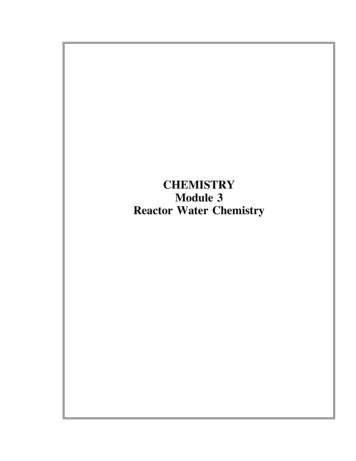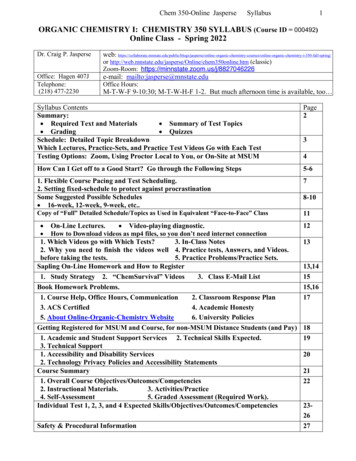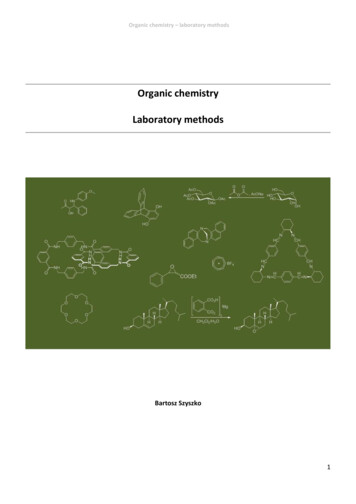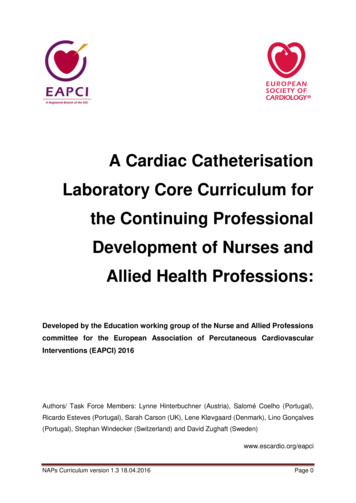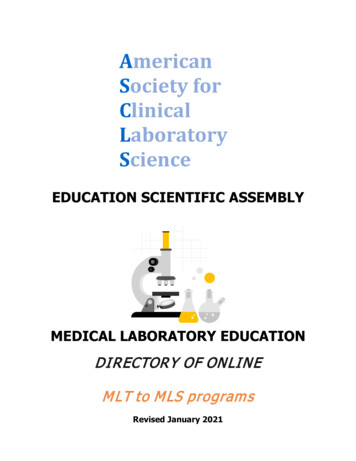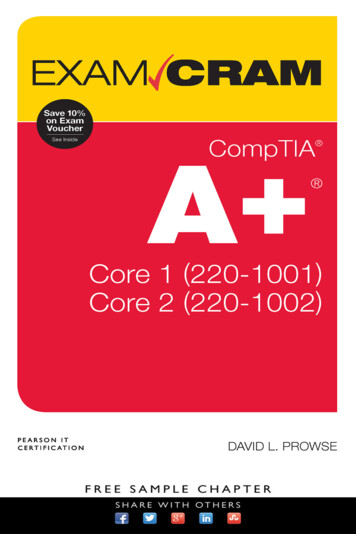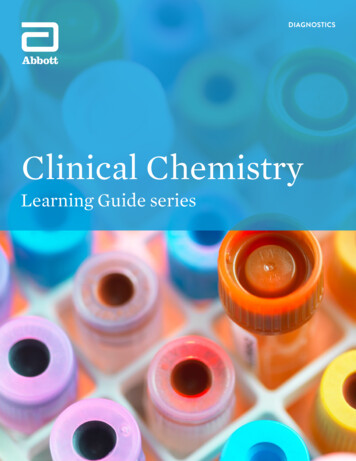
Transcription
DIAGNOSTICSClinical ChemistryLearning Guide series
ABBOTT DIAGNOSTICSCLINICAL CHEMISTRYEDUCATIONAL SERVICESINTENDED AUDIENCEThis learning guide is intended to serve the basic educational needs ofnew medical laboratory scientists who are entering the field of clinicallaboratory medicine. Anyone associated with the specialty of clinicalchemistry or the clinical laboratory will find this learning guide ofinterest. Typical readers will include medical laboratory technicians andmedical technologists, laboratory supervisors and managers, nurses,laboratory support personnel and physician office laboratory personnel.HOW TO USE THIS LEARNING GUIDETo offer the most benefit, this learning guide begins each section withan Overview so you can quickly review its goals and content. Next is aset of Learning Objectives. These focus on the key concepts presentedin each section. There is a short Review quiz at the end of each sectiondesigned to help recall the concepts introduced. If a question is answeredincorrectly, the appropriate portions of the text may be reviewed beforemoving to the next section.A glossary is at the end of this learning guide for quick reference. Thereare also references and resources devoted to other recommended readingfor more details and further study.AUTHOR:Roberta Reed, Ph.D.ABBOTT EDITORS:David Armbruster, Ph.D., DABCC, FACB, Director, Clinical ChemistryKelley Cooper, MT (ASCP), CLS (NCA), Global Clinical Chemistry MarketingLEARNING GUIDE: CLINICAL CHEMISTRY2T O T H E TA B L E O F C O N T E N T S
FOREWORDClinical Chemistry is an exciting field that combines analytics andinstrumentation with information technology and management of workflow,staff efficiencies and high volume automation. The field is ever-changingand demands staff have skills in the methodologies and their limitations,technology and troubleshooting equipment, as well as management and abilityto adapt operations to evolving clinical needs. At the heart, the laboratory isa service to the physician providing test results that are critical to diagnosingand managing patients. But, the laboratory is also a vital member of thehealthcare team and gets involved in utilization, operational efficiencies andimproving patient outcomes. I was honored to be asked to edit this version ofthe Clinical Chemistry Learning Guide, as I have spent nearly 30 years in theclinical laboratory mentoring students and helping physicians meet the needsof their patients.This Learning Guide is an essential primer to the basics of not only clinicalchemistry but laboratory medicine. It touches on quality and essentials of themethodologies we utilize in the daily analysis of specimens. A wide range ofclinical disciplines, including nursing students, researchers, medical students,residents, lab administrators and government inspectors as well as medicaltechnologists, may find the contents of this guide to be helpful to their dailywork and an explanation of what goes on in the clinical laboratory to thosethat are not aware of the science. I hope that you will find this guide as usefulas my students and technologists have in the past!James H. Nichols, Ph.D., DABCC, FACBProfessor of Pathology, Microbiology andImmunologyMedical Director of Clinical ChemistryMedical Director, Point-of-Care TestingVanderbilt University School of Medicine4918D TVC (The Vanderbilt Clinic)1301 Medical Center DriveNashville, TN 37232-5310(615) 343-5708FAX (615) 343-9563james.h.nichols@vanderbilt.eduLEARNING GUIDE: CLINICAL CHEMISTRY3T O T H E TA B L E O F C O N T E N T S
CONTENTSINTRODUCTIONCLINICAL CHEMISTRY LEARNING GUIDE . . . . . . . . . . . . . . . . . . . . . . . . . . . . . . . . . . . . 5SECTION 1INTRODUCTION TO CLINICAL CHEMISTRY . . . . . . . . . . . . . . . . . . . . . . . . . . . . . . . . . . 6SECTION 2PRINCIPLES OF MEASUREMENT . . . . . . . . . . . . . . . . . . . . . . . . . . . . . . . . . . . . . . . . . . . . 18SECTION 3TESTING STRATEGIES TO SELECT FOR A SPECIFIC ANALYTE . . . . . . . . . . . . . . . . 30SECTION 4ACCURACY . . . . . . . . . . . . . . . . . . . . . . . . . . . . . . . . . . . . . . . . . . . . . . . . . . . . . . . . . . . . . . . . . 41SECTION 5SOURCES OF ERROR . . . . . . . . . . . . . . . . . . . . . . . . . . . . . . . . . . . . . . . . . . . . . . . . . . . . . . . 55SECTION 6COMMON CLINICAL CHEMISTRY TESTS . . . . . . . . . . . . . . . . . . . . . . . . . . . . . . . . . . . . 66SECTION 7TESTING IN CLINICAL PRACTICE . . . . . . . . . . . . . . . . . . . . . . . . . . . . . . . . . . . . . . . . . . . . 88SECTION 8UNITS OF MEASURE . . . . . . . . . . . . . . . . . . . . . . . . . . . . . . . . . . . . . . . . . . . . . . . . . . . . . . . 105APPENDIXAPPENDIX A: GLOSSARY OF TERMS . . . . . . . . . . . . . . . . . . . . . . . . . . . . . . . . . . . . . . . . 112APPENDIX B: REFERENCES . . . . . . . . . . . . . . . . . . . . . . . . . . . . . . . . . . . . . . . . . . . . . . . . . 115APPENDIX C: CORRECT RESPONSES TO REVIEW QUESTIONS . . . . . . . . . . . . . 116LEARNING GUIDE: CLINICAL CHEMISTRY4
INTRODUCTIONCLINICAL CHEMISTRYLEARNING GUIDEClinical laboratory science consists of various specialties such as clinicalchemistry, hematology, immunology, microbiology, serology, toxicologyand urinalysis. This learning guide focuses on the major specialty ofclinical chemistry, which encompasses a wide variety of tests and is amajor area of concentration in hospital and reference core laboratories.Clinical chemistry uses many different methodologies, manual and fullyautomated tests, examines both very common and esoteric analytes,mixes basic chemistry with biochemistry, engineering, informatics andother disciplines, and overlaps with other areas of concentration, inparticular, toxicology and endocrinology.Because of the scope and depth of clinical chemistry, many excellenttextbooks have been written on the subject. Those textbooks are routinelyrevised and updated to keep pace with developments in this dynamicfield. This learning guide is only intended as a primer on the subject.It introduces basic concepts and is intended to provide the minimumfundamentals. It is hoped that this guide will answer elementaryquestions about clinical chemistry and stimulate further interest in thesubject. Readers are encouraged to consult Appendix B: References formore comprehensive and detailed information about this specialty.We hope this Clinical Chemistry Learning Guide from Abbott Diagnosticsproves to be a useful tool to help you establish firm footing in the field oflaboratory medicine.LEARNING GUIDE: CLINICAL CHEMISTRY5B A C K T O T H E TA B L E O F C O N T E N T S
SECTION 1INTRODUCTION TOCLINICAL CHEMISTRYOVERVIEWThis section identifies the scope of clinical chemistry testing, includingthe types of biologic samples that are typically analyzed and how testresults may be interpreted.LEARNING OBJECTIVESAfter completing this section you should be able to: D escribe the kinds of analytes that are measured using clinicalchemistry tests I dentify different types of biologic specimens that may be usedfor testing D escribe how the results of tests are interpretedKEY CONCEPTS1. C linical chemistry tests measure concentrations or activities ofsubstances (ions, molecules, complexes) in body fluids.2. T hese tests may use different kinds of body fluids such as whole blood,plasma, serum, urine and cerebrospinal fluid.3. T he medical interpretation of a test result is based on comparison to areference interval that typically reflects the range of values expectedfor healthy people or a medical decision level (MDL) for the diagnosisand treatment of disease.The reader should consult Appendix B: References for more detailedinformation about these topics, especially Tietz Fundamentals of ClinicalChemistry and Molecular Diagnostics, 7th Edition, 2015, and the websiteLab Tests Online, www.labtestsonline.org.L E A RNING G UIDE: IN T RO DUC T IO N TO CL INIC A L CHE MIS T RY6B A C K T O T H E TA B L E O F C O N T E N T S
Clinical chemistry is a quantitative science that is concerned with measurement of amounts of biologicallyimportant substances (called analytes) in body fluids. The methods to measure these substances are carefullydesigned to provide accurate assessments of their concentration. The results of clinical chemistry tests arecompared to reference intervals or a medical decision level (MDL) to provide diagnostic and clinical meaningfor the values.COMMON ANALYTESClinical chemistry is the branch of laboratory medicine that focuses primarily on molecules. The tests in aclinical chemistry laboratory measure concentrations of biologically important ions (salts and minerals),small organic molecules and large macromolecules (primarily proteins). See Section 6 for more detail aboutspecific analytes.COMMON ANALYTES IN THE CLINICAL CHEMISTRY LABORATORYIONS, SALTS AND MINERALSSMALL ORGANIC MOLECULESLARGE iumPhosphorusCarbon Dioxide ic n CTransport ProteinsAlbuminTransferrinHaptoglobinFerritinTotal ProteinTherapeutic c acidToxicologyAlcohol (ethanol)Salicylate (aspirin)AcetaminophenDrugs of Abuse noidsL E A RNING G UIDE: IN T RO DUC T IO N TO CL INIC A L CHE MIS T RY7EnzymesLipaseAmylaseAlanine Aminotransferase (ALT)Aspartate Aminotransferase (AST)Alkaline Phosphatase (AlkP)Lactate Dehydrogenase (LD)Creatine Kinase (CK)Specific ProteinsImmunoglobulins (IgA, IgG, IgM)Complement C3Complement C4C-Reactive Protein (CRP)LipoproteinsHigh Density Lipoprotein (HDL)Low Density Lipoprotein (LDL)Lipoprotein (a)Diabetes MarkerHemoglobin A1c (HbA1c)B A C K T O T H E TA B L E O F C O N T E N T S
COMBINATIONS OF TESTS (PANELS)When an individual test alone is not sufficient to assess a medical condition, a combination of several testsmay be used. The pattern of results from the combination of tests may provide better insight into the statusof the patient than any single test result. Such tests, done on the same sample, are often ordered as a groupcalled a panel or profile.The types of panels and the specific tests included in panels reflect local, regional or national practices. Evenfor panels with the same name, the individual tests included may differ from institution to institution.EXAMPLES OF TYPICAL PANELS OF TESTSHEPATIC PANEL(LIVER PROFILE)COMPREHENSIVEMETABOLIC PROFILESodium (Na)Potassium (K)Chloride (Cl)Carbon Dioxide (CO2)AlbuminTotal ProteinAlkaline PhosphataseAlanine Aminotransferase (ALT)Aspartate Aminotransferase (AST)Total BilirubinDirect BilirubinSodium (Na)Potassium (K)Chloride (Cl)Carbon Dioxide (CO2)GlucoseCreatinineUreaCalciumTotal ProteinAlbuminAlanine Aminotransferase (ALT)Aspartate Aminotransferase (AST)Alkaline Phosphatase (AlkP)Total BilirubinBASIC METABOLIC PANELLIPID PROFILESodium (Na)Potassium (K)Chloride (Cl)Carbon Dioxide (CO2)GlucoseCreatinineUrea (blood urea nitrogen; BUN)Total CholesterolLDL CholesterolHDL CholesterolTriglyceridesELECTROLYTE PANELL E A RNING G UIDE: IN T RO DUC T IO N TO CL INIC A L CHE MIS T RY8B A C K T O T H E TA B L E O F C O N T E N T S
BIOLOGIC SPECIMENSBlood is the most common biologic fluid collected for clinical laboratory testing. It is usually drawn from avein (in the arm) directly into an evacuated tube. Typically a tube will hold about 5 mL of blood – enough toperform many clinical chemistry tests, since automated analyzers require only small amounts (usually from2 to 100 μL) for a single test. Occasionally, when collection of blood from a vein is difficult, a sample ofcapillary blood may be collected by pricking the skin and collecting several drops of blood from thepuncture site. An example is the use of heelstick blood for testing of newborns.Phlebotomy – the act of drawing ablood sample from a blood vessel.For clinical chemistry testing, bloodis usually drawn from a vein, typicallya vein in the arm or back of thehand. Collecting blood from a vein iscalled venipuncture. The medicalprofessional drawing the bloodsample is called a phlebotomist.Other biologic fluids (matrices) often used for testing include urine, saliva, cerebrospinal fluid (CSF),amniotic fluid, synovial fluid, pleural fluid, peritoneal fluid and pericardial fluid. These fluids often containthe same biologic analytes of interest – such as glucose and protein – but differ greatly from each other inphysical and chemical properties. These differences in fluid characteristics are termed matrix differences.Test methods that are designed for determination of an analyte in blood plasma may not be suitable fordetermination of that same analyte in other fluids (other matrices). When using a test method for analysis ofa fluid other than blood plasma or serum, it is important to validate that the method is acceptable for the typeof fluid sample being used.FLUIDS TYPICALLY USED FOR CLINICAL CHEMISTRY TESTSBlood (whole blood, serum or plasma)UrineCerebrospinal fluid (CSF)Amniotic fluidSalivaSynovial fluid (fluid that is found in joint cavities)Pleural fluid (from the sac surrounding the lungs)Pericardial fluid (from the sac surrounding the heart)Peritoneal fluid (also called ascitic fluid; from the abdomen)L E A RNING G UIDE: IN T RO DUC T IO N TO CL INIC A L CHE MIS T RY9B A C K T O T H E TA B L E O F C O N T E N T S
BLOODFigure used1-1. specimenPreparationof
clinical laboratory mentoring students and helping physicians meet the needs of their patients. This Learning Guide is an essential primer to the basics of not only clinical chemistry but laboratory medicine. It touches on quality and essentials of the methodologies we utilize in the daily analysis of specimens. A wide range of clinical disciplines, including nursing students, researchers .




